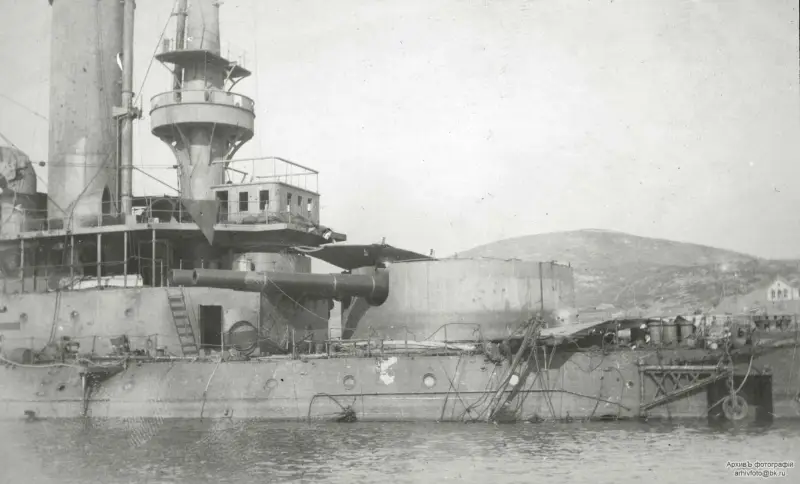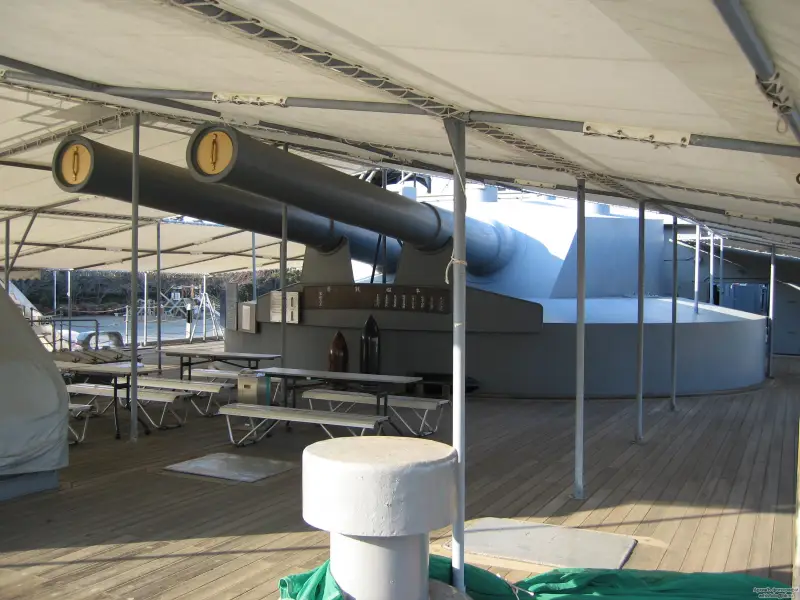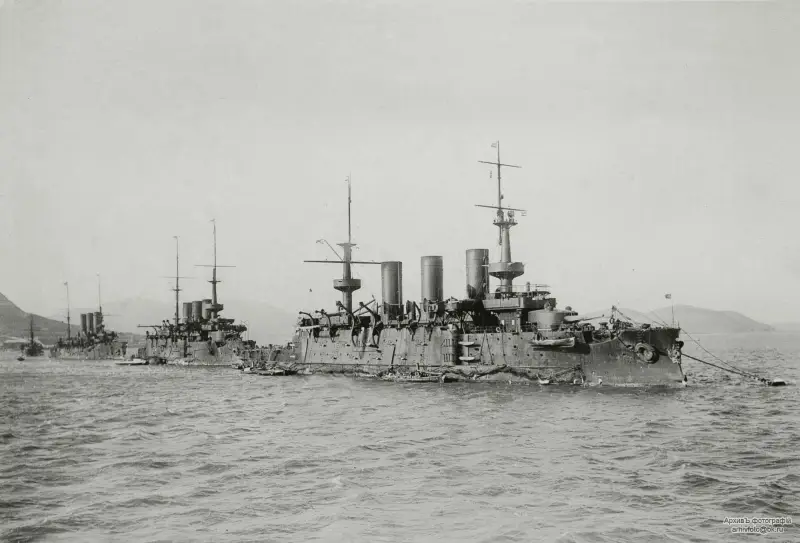How not to make shells, or the Russian 305-mm land mine mod. 1894

We continue the theme of domestic twelve-inch shells.
High-explosive 305-mm projectile mod. 1894
A lot has already been said about the tragedy with domestic high-explosive shells from the era of the Russian-Japanese War, including by me. We managed to provide the fleet with 305-mm high-explosive shells with a pitifully small amount of explosives, which was aggravated by the inability to equip them with pyroxylin.
At the same time, the shells were deprived of instantaneous fuses, which is why they did not explode upon impact with water, making it difficult to target at long distances. And at such distances it was necessary to shoot at the Russian-Japanese - this was throw-over fire at the Japanese battleships, which had taken the fashion of shelling the inner harbor of Port Arthur, and the first phase of the battle at Shantung.
At the same time, the relatively low-quality steel from which these shells were made did not allow them to be considered as a subtype of armor-piercing ammunition.
Why are there so few explosives?
As you know, the Rudnitsky plant, “which had the opportunity to study the production of shells of this kind abroad,” in 1889 presented to the MTK 6-dm high-explosive steel “bombs” with an explosive content of 18 to 22,5% of the total mass of the loaded projectile. The “Attitude of the Naval Technical Committee to the Chairman of the Investigative Commission in the Case of the Tsushima Battle” describes a heartbreaking story the inability of the domestic industry to produce high-quality steel, which was required to produce such projectiles:
Therefore, they created a simpler drawing, in which the projectile had an explosive content of only 7,7% of the total weight of the projectiles. But, since the factories could not cope with this task, they reduced the payload weight to (on average) 3,5%.
Here, of course, the question arises: why did Russia know how to make steel for high-quality armor-piercing shells, but could not make it for high-explosive shells?
For a long time, guided by the above “Attitude,” I was confident that steel for armor-piercing projectiles should differ in quality from steel for high-explosive projectiles. But, as it recently turned out, I was wrong, if not completely, then at least partially.
Professor E. A. Berkalov in his work “Design of Naval Artillery Shells” indicates:
Price issue
And indeed, in “Calculation No. 1 of the cost of shells and other items in the amount of half of the second combat kit for ships sailing to the Pacific Ocean” we read:
– the price of an armor-piercing 305-mm projectile is 535 rubles. 80 kop. (without charge cost and, as far as I understand, without fuse);
– the price of a high-explosive 305-mm projectile is 155 rubles. 00 kop.
Accordingly, assuming that a high-explosive projectile made of high-grade steel will not differ in price from an armor-piercing one (and only a few percent less steel is used for it), we find that the savings on one projectile amounted to 380 rubles. 80 kop. What economies of scale will this provide? fleet?
Unfortunately, the situation with the ammunition of our battleships is not entirely clear. In the 80s of the 18th century, it was 18 armor-piercing, 18 high-explosive steel, 4 cast iron, 2 segment and 60 grapeshot shells, and a total of 305 shells per 40 mm/1889 gun. But in 1901 it was decided to remove cast iron shells from service. The implementation of this decision was delayed - for example, the Pacific Squadron excluded cast iron shells from ammunition only in 18 (they were returned to the war, but more on that later). The squadron battleships leaving for Tsushima each had 36 armor-piercing, 6 high-explosive steel and 305 segmental XNUMX-mm shells per gun.
But still, according to some data, the fleet sought a different composition, namely: 27 armor-piercing, 27 high-explosive steel and 6 segment projectiles. This is not at all surprising, since it was the armor-piercing projectile that was relied upon as the main type of ammunition in the Russian Imperial Navy.
In any case, the number of steel armor-piercing and high-explosive shells was supposed to be 54 shells per gun, but in fact only 18 armor-piercing shells were made from high-quality steel. The difference is 36 shells for one gun and 144 for the ammunition load for a squadron battleship. But one ship was entitled to two ammunition loads. Accordingly, the use of cheap high-explosive shells saved 54 rubles. 832 kopecks for ammunition and 20 rubles. 109 kopecks - on a battleship.
Profit!
Agree that for our Naval Ministry of those years, which managed not to find 70 rubles for testing new steel armor-piercing and high-explosive shells “to determine their destructive effect,” a saving of more than 000 thousand rubles, and not one-time, but for each new one under construction The battleship is just some kind of fairy tale!
True, as a result, our sailors had to fight with shells containing less than 15 pounds of smokeless powder, while the Japanese “suitcases” were equipped with approximately 100 pounds of “shimoza”.

But not in rubles alone
However, in fairness, it should be admitted that the heavy Russian high-explosive shell became a victim not only of domestic stinginess, but also of the general concept of naval combat, as it was seen then.
At the end of the 25th century, when our best battleships that fought in the Russo-Japanese war were being designed, no one was going to arrange “shooting battles” at distances exceeding 30–15 cables. The distance of a decisive battle was supposed to be 20–20 cables, or even less. But at the same 229 cables, the domestic armor-piercing projectile should have confidently penetrated 15 mm Krupp armor, and at 305 cables - even XNUMX mm, which was still hard to find on battleships of those years.
Consequently, according to the tacticians of those years, it was armor-piercing shells that should have become the means of inflicting decisive damage at the main battle distances. The role of high-explosive shells was limited to only short-term shelling of enemy ships until they converged with ours within the same 15–20 cables, as well as to perform, although important, but still secondary tasks, such as shelling coastal targets.
Thus, the high-explosive projectile seemed, rather, to be an auxiliary ammunition, which is why saving on it could be considered quite advisable.
This point of view is fully confirmed by the fact that work on improving armor-piercing shells in Russia was carried out very, very intensively. At the end of the 19th and beginning of the 20th centuries, many tests were carried out with “Makarov” tips - in contrast to testing the effectiveness of the armor-piercing effect of armor-piercing shells, the Navy Ministry found money for this. In addition, in accordance with the established rules, the armor-piercing qualities of the shells were checked by actual firing - for each batch fired.
But nothing like that happened with high-explosive shells.
It is interesting that, on the one hand, the MTK understood perfectly well that the high-explosive projectile mod. 1894 is essentially not such, which is why “there was no reason to assign a particularly sensitive tube to these shells, and they were equipped with double shock tubes,” that is, the same fuses as armor-piercing ones.
On the other hand, high-explosive shells were not subject to tests for armor penetration. E. A. Berkalov managed to find only a single case of testing a 305-mm land mine (without explosives), which took place on July 23, 1904. One shot was fired with a deflection of 25 degrees. from normal to 305 mm armor plate, hardened using the Krupp method. At the same time, the projectile speed on the armor was 2 f./sec. or almost 594 m/s, that is, almost muzzle.
As a result, a 24-inch plug was knocked out in the slab, but, unfortunately, E. A. Berkalov did not indicate what happened to the projectile. Most likely it collapsed. The respected professor only stated that he had no idea about the purpose of such a test, since “such an experiment, of course, could not illustrate how the said projectile would act at actual impact speeds and in loaded form.”
Our sailors, again, had to pay for the installation of the “double shock” tube. It can be assumed that if the large-caliber shells of the 1st Pacific Squadron had exploded when falling into the water, then in the battle on July 28 it would have been much easier for our artillerymen to adjust fire on the Japanese battleships while they were fighting at long distances.
But why was it necessary to save on shells at all?
A few words in defense of the Navy Ministry
The construction and equipping of a fleet is a complex process in which many ministries, departments, industrial enterprises, etc. are involved. When assessing certain decisions of the Ministry of Transport and Communications, one must take into account the environment in which the Maritime Ministry had to work in those years.
On the one hand, it was necessary to build a fleet, and urgently. For this, money was needed. But progress flew forward by leaps and bounds, the ships literally became obsolete on the stocks. You can make an estimate for a shipbuilding program for several years in advance, but closer to its completion, the cost of warships will be completely different from what was calculated. But the budget will remain the same, and it will be necessary to go with an outstretched hand, asking for extra-budgetary allocations.
But the Ministry of Finance, represented by S. Yu. Witte, was not at all ready to respond sensitively to the needs and desires of the fleet. The most egregious case is well known: when the deadline for the completion of the new shipbuilding program “For the needs of the Far East,” approved by the Emperor in 1898, was, at the insistence of the Ministry of Finance, shifted from the end of 1902 to the beginning of 1905. Due to the fact that the Ministry of Finance believed that Japan, against which the program was oriented, would produce its fleet for war no earlier than 1905.
And here is another example.
There is a known letter signed by Vice Admiral Avelan dated July 19, 1900, addressed to the Minister of Finance S. Yu. Witte. It began like this: “Dear Sir, Sergei Yulievich. Currently, the fleet does not have a second combat set of artillery supplies...” It was further indicated that this combat set would cost the treasury 22 rubles, of which only 600 rubles were allocated. – as much as 000%! Avelan asked that same year to allocate another 1 rubles, and then 000 rubles each. annually, so that the entire amount is received before January 000, 4,4.
This application was considered at a special meeting on the issue of additional allocations to the marginal budget of the Maritime Ministry for the period 1900–1904. And it was rejected. Later they returned to her and rejected her again. According to, as was customary to write in documents of that era, the highest instructions. It is clear that this instruction was formed on the basis of reports from the Ministry of Finance, but for the Maritime Ministry this, of course, did not change anything.
As a result, of the 21,6 million funds requested by Avelan’s letter, only 1,3 million rubles were allocated in 1900 and 1,8 million rubles in 1903. It is clear that with the outbreak of hostilities, money was found in a fabulous way, and at the beginning of 1904, 10,7 million rubles were quickly found for the purchase of shells. Of course, it was already too late, even taking into account the placement of some orders abroad.
This is how it turned out that at the beginning of the war, the 1st Pacific Squadron had only one set of shells, and the second one was missing 50% of the 254-305 mm caliber, 60% of the 152 mm, and there was almost no 75 mm at all. Although there is a catch with the latter - perhaps there were still shells, but there was no gunpowder for their equipment/charges, since the reasons for their absence include the rejection of 2 pounds of gunpowder that had begun to decompose.

And you need to understand that money is only the beginning of the matter, because not everything could be solved with timely budget allocations. After all, even those shells for which we managed to place orders, we could not properly equip. Our high-explosive 305-mm shells, with which the fleet went to Tsushima, were not filled with pyroxylin, but with gunpowder.
The issue of equipping the shells of the 1st Pacific is also interesting - in the notes of V.N. Cherkasov, the artillery officer of the squadron battleship "Peresvet", it was indicated that only shells for guns with calibers of 6-dm, 8-dm and 10-dm were equipped with pyroxylin, and ammunition for twelve-inch guns and guns smaller than 152 mm had to be content with smokeless powder. The coastal guns of Port Arthur did not even have this.
It can be assumed that even in the presence of effective demand, the domestic industry still did not have time to provide the number of shells and charges we needed. What if, instead of landmines of a “simple design” made of second-rate steel, and with a minimum of explosives at that, we ordered first-class landmines from domestic enterprises? Would industry have enough resources to produce them in a timely manner?
And again, we can say that in such an occasion, the Ministry of Transport and Communications should “roll up its sleeves” and agree, as it is fashionable to say now, on a project for the production of new type projectiles, choose a private owner, help him with investments, etc. This, by the way, is very correct and state approach.
But let’s not forget that the Maritime Ministry was constantly engaged in such projects, spending significant sums on it. It was the Naval Ministry that tirelessly supported the famous Obukhov plant, paying its obligations, sponsoring the expansion of production, and ultimately finally bought it back to the treasury in 1886. Despite the fact that the plant was actually managed by representatives of the Maritime Ministry since 1865.
What could be done if the “invisible hand of the market” did not have enough strength to meet the ever-increasing demands of the Russian army and navy?
The Baltic Shipyard, which became an exemplary St. Petersburg shipbuilding enterprise, also did not keep up when it was in private hands, and was eventually purchased by the Maritime Ministry in 1894.
And the question was not only about increasing the number of ships being built, but also about developing domestic industry through localizing production in Russia. It’s not that the trio of Petropavlovsk-class battleships were “screwdriver-built”, but still the bulk of the vertical armor for them was ordered abroad, as were two of the three running gear. A completely different matter is the series of Borodino-class battleships.
In essence, the fleet was built in conditions where the costs of its creation tended to grow uncontrollably, budget allocations for agreed programs could suddenly “move to the right,” and the level of domestic industry did not meet the tasks facing it. And the Navy Ministry had to somehow balance all this in search of the best solutions.
I would especially like to note that I am infinitely far from idealizing the Navy Ministry in general and “7 pounds of august meat” in particular. And I’m absolutely not going to make them out to be victims of circumstances. Many mistakes were made, and completely unforgivable ones.
The question is not whether the Navy Ministry could, in one way or another, ensure a high level of combat training for the fleet and the quality of ammunition, even at the cost of reducing the number of ships in construction. The question is that it didn’t even make such an attempt. And the inability to find 70 thousand rubles to test the fighting qualities of the main weapons fleet - steel high-explosive and armor-piercing shells, generally does not lend itself to any censorship description.
Conclusions
Today it is absolutely obvious that saving on combat training and the quality of ammunition is absolutely unacceptable. Therefore, judging from the perspective of our time, the refusal to create an effective 305-mm high-explosive projectile looks like a stupid, unforgivable and completely inexplicable mistake.
However, if we take into account the limited solvency of the Navy Ministry, the need for savings, the tactical views of the fleet and the general level of domestic industry, this mistake, while remaining unforgivable, becomes at least understandable.
To be continued ...
Information